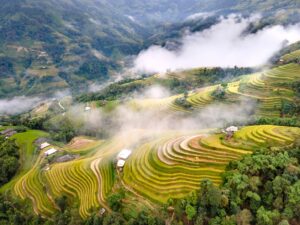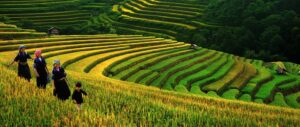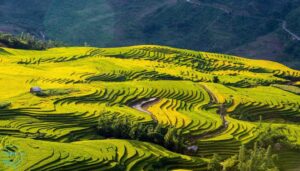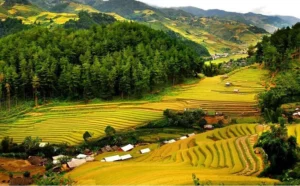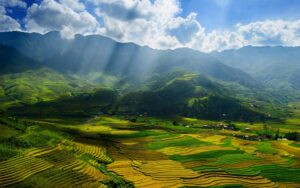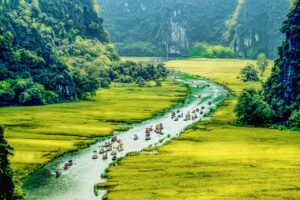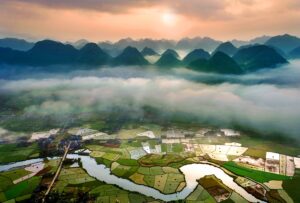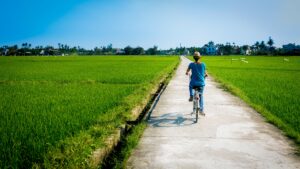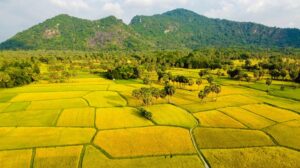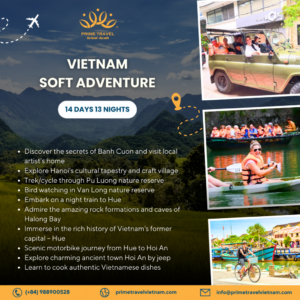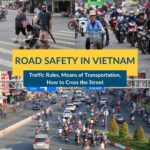
Where to See Rice Fields in Vietnam?
For thousands of years, rice has been at the heart of Vietnamese culture and daily life. As a country shaped by wet rice farming, Vietnam is home to breathtaking rice fields that reflect both its rich history and stunning landscapes.
From lowland paddies in the Mekong Delta to mountain-side terrace fields in the north, each region offers a different glimpse into Vietnam’s agricultural soul. These lush green fields and golden crops are more than just scenic; they represent generations of hard work, tradition, and harmony with nature.
If you’re planning a trip and wondering where to see rice fields in Vietnam, Prime Travel will take you through the most scenic spots, the best times to visit, and tips to enjoy the beauty of Vietnam rice fields at their finest.
When Is the Best Time To See Rice Fields in Vietnam?
The best time to see rice fields in Vietnam depends on the region, as planting and harvest seasons vary across the country. From lush green paddies to golden terraces, timing your visit right ensures the most stunning views.
In Northern Vietnam
Places like Mu Cang Chai, Sapa, and Hoang Su Phi typically have one rice crop per year. To better prepare for it, travelers should know about the cycle here:
- March to May is the water filling season, when the terraces reflect the sky like mirrors.
- From May to July, fields turn green during the growing period.
- The most photogenic time is late September to early October, when golden rice terraces stretch across the mountains.
- November to February is known as the fallow period with empty fields. However, there is so much more to explore in this region other than the terrace fields.
In Central Vietnam
Areas like Pu Luong or Mai Chau enjoy a milder climate and support two rice crops each year.
- The first growing cycle is from February to May.
- May to June is when the first harvest takes place, offering a stunning view of golden rice fields.
- A second crop is planted in July, with another harvest in September or early October.
These cycles give travelers more chances to catch both vibrant green and golden rice fields in Vietnam.
In the South
In the Mekong Delta, rice is grown year-round due to the tropical climate. However, avoid visiting between June and August, when floods can affect over half the region. For the best views, dry season months from December to February offer cooler weather and clearer skies.
To make the most of your trip, consider planning your route to follow the harvest, from the golden rice terraces of the north to the evergreen paddies in the south. It’s one of the best ways to truly experience the charm and diversity of Vietnam rice fields.
If you are not familiar with the weather in Vietnam yet, check out our blog Vietnam Weather by Month: A Traveler’s Guide to prepare for your trip.
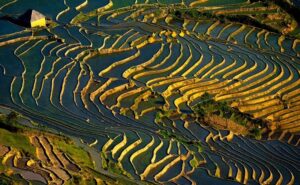
Beautiful scenery of rice fields during the watering season
Where to See Rice Fields in Vietnam
Without a doubt, Vietnam offers some of the most picturesque rice landscapes in Asia, showcasing not only breathtaking landscapes but also Vietnam’s rich cultural heritage. If you’re wondering where to see rice terraces in Vietnam, this list of the 10 best rice fields will help you plan.
Mu Cang Chai
Mu Cang Chai is one of the most iconic places to see rice terraces in Vietnam. Located in Yen Bai province, this remote area is known for its dramatic mountain slopes carved into breathtaking terrace fields.
The terraced fields here cover more than 2,000 hectares and are recognized as a national heritage site. The best time to visit Mu Cang Chai is from September to early October, when the rice ripens and the hills glow golden. The combination of cool air, golden rice, and stunning highland scenery makes it a favorite for photographers and nature lovers.
These rice terraces are mainly farmed by the Hmong ethnic group, who use traditional techniques passed down through generations. Their farming patterns follow the natural curves of the hills, creating a unique and harmonious landscape.
Visitors can explore villages like La Pan Tan, Che Cu Nha, and De Xu Phinh — all officially recognized as national heritage sites for their beauty. You’ll find fewer crowds here compared to Sapa, offering a more authentic and peaceful experience.
Hoang Su Phi
Tucked away in the far northern mountains of Ha Giang province, Hoang Su Phi is a hidden gem for those seeking untouched rice terraces in Vietnam. It’s less touristy than Sapa or Mu Cang Chai but just as stunning, maybe even more so.
The terraces here are dramatically layered on steep mountain slopes and you probably see local ethnic groups like the Dao and La Chi working on it. The fields stretch as far as the eye can see, often shrouded in mist, offering a surreal and majestic atmosphere.
The best time to visit Hoang Su Phi is during the golden harvest season from mid-September to early October. During this time, the terrace fields shine in rich shades of yellow and gold, creating breathtaking views at sunrise and sunset. But if you prefer the water filling season, it lasts from March until May.
Unlike other destinations, Hoang Su Phi offers a raw, remote experience with very few crowds. You can also visit during the water pouring season (May to June), when terraces become shimmering mirrors reflecting the sky.
Popular spots include Ban Phung, Nam Hong, Nam Ty, and Thong Nguyen. Most require some walking or motorbike access, but the journey offers rewarding views and authentic cultural encounters.
For adventure seekers, Hoang Su Phi offers challenging hiking routes to Chieu Lau Thi (2,402m) and Tay Con Linh (2,427m), offering an escape to the wilderness. Just remember that you shouldn’t go on a hiking trip in the rainy season. It’s extremely dangerous due to a sudden landslide on the trail.
Read more>>>Escape the Heat: 10 Best Summer Destinations in Northern Vietnam
Sapa
Sapa is one of the most famous places to see rice terraces in Vietnam, and for good reason. Nestled in Lao Cai province near the Chinese border, Sapa offers spectacular landscapes, cool weather, and rich cultural diversity.
The terrace fields in Sapa are best seen in two key seasons: from May to June during the water season, and from September to early October when they turn golden and are ready for harvest.
Popular rice field areas in Sapa include Lao Chai, Ta Van, and Ta Phin villages. These spots are perfect for hiking, riding a motorbike to explore, or even spending a night at homestays.
In addition to the views, what makes Sapa truly special is the chance to meet ethnic minority groups like the Hmong, Red Dao, and Tay. Many local families still farm these rice terraces by hand, offering visitors an authentic glimpse into rural life.
Y Ty
Y Ty is located in Bat Xat district, Lao Cai province, which is about 70 km away from Sapa. It remains one of the most underrated places to see rice terraces in Vietnam. Located at an altitude of over 2,000 meters, it offers a peaceful, untouched alternative to the more touristy Sapa.
The rice terraces in Y Ty are incredibly scenic. During late September and early October, these fields turn golden, creating a breathtaking contrast with the sea of clouds and mountain peaks.
Y Ty is also home to ethnic minority communities like the Ha Nhi, known for their beautiful traditional dresses and building unique earth-walled houses with clay walls and thatched straw roofs.
For adventurous travelers, Y Ty is also a starting point on the trekking journey to Lao Than Peak (2860m). This trekking route is well-known for beginners, but it still requires participants to exercise regularly to best prepare for it.
Mai Chau
Nestled in a peaceful valley surrounded by towering limestone mountains, Mai Chau offers a more relaxed alternative to the northern terrace fields.
While it doesn’t have dramatically highland rice terraces like Mu Cang Chai or Y Ty, Mai Chau’s flat, green paddies paint a picture of rural tranquility. It’s an ideal stop for those looking to enjoy Vietnam rice fields without long treks or high altitudes.
Mai Chau is also home to the Thai ethnic minority, known for their stilt houses, handwoven textiles, and warm hospitality. Staying overnight in a traditional homestay lets you experience daily life in the rice fields, from planting to harvesting, and connect with the rhythms of local culture.
The best time to visit is when the rice paddies are lush and golden, between late May and early June, or September and October. It’s slightly different from the golden season in Northwest Vietnam because Mai Chau has two rice crop seasons per year.
Pu Luong
Tucked away in the mountains of Thanh Hoa Province, Pu Luong is a hidden gem known for its peaceful atmosphere and striking rice terraces.
Unlike the busier tourist spots, this region remains largely untouched, offering travelers a chance to explore Vietnam rice fields in a serene and authentic setting. The terrace fields here stretch across hillsides, blending perfectly with bamboo forests and stilt houses.
Pu Luong is home to Thai and Muong ethnic communities who maintain a traditional lifestyle tied closely to nature. Visiting during the first harvest season (May–June) or the second (September–October) gives you the chance to witness vibrant green or golden terrace fields.
Some popular spots for first-timers here include: Kho Muong Village, Bat Cave, Don Village, Hieu Waterfall, etc. Whether you’re trekking through the hills or relaxing at an eco-lodge, Pu Luong is perfect for travelers seeking both beauty and calm.
If you are interested in visiting Pu Luong, don’t forget to read our blog Top Things To Do In Pu Luong Nature Reserve – The Ultimate Guide 2025.
Ninh Binh
Ninh Binh is one of the most accessible places to see rice fields in Vietnam, just a two-hour drive from Hanoi.
Known as “Ha Long Bay on land,” it offers a magical blend of limestone karsts, lush valleys, and vast rice paddies. The flat terrain, winding rivers, and dramatic cliffs make it a dream for both photographers and families looking for gentle countryside escapes.
During the summer months, especially in late May to early June, the rice fields in Tam Coc and Trang An turn a brilliant shade of green and gold.
The best way to experience this landscape is by taking a traditional sampan boat ride, drifting through rice fields surrounded by limestone karsts. You can also cycle through the countryside or hike up to Hang Mua for panoramic views of the rice-filled valleys below.
Read more>>>A Complete Ninh Binh Guide: Everything You Need for a Perfect Trip
Bac Son Valley
Bac Son Valley, located in Lang Son Province in northeastern Vietnam, is a hidden gem for those seeking stunning rice field views away from tourist crowds.
Surrounded by rolling limestone mountains and scattered ethnic Tay villages, the valley offers a spectacular natural setting where rice paddies stretch in every direction, forming patchworks of vivid greens and golden hues.
What makes Bac Son unique is its lower elevation, which allows for multiple harvests each year. The best time to see the golden rice fields is typically from late July to mid-November.
For the most breathtaking views, hike up to Na Lay Peak at sunrise or sunset, when the valley is covered in mist and soft light.
Hoi An
Hoi An may be famous for its lantern-lit streets and ancient architecture, but just outside the town, you’ll find peaceful rice fields that offer a quieter, more rural charm. These flat paddies stretch across the countryside and are easily accessible by bicycle or scooter, making it a great destination for families and casual explorers.
There are two seasons in Hoi An: the winter-spring season from December to April the next year and the autumn-fall season from May to September. The rice fields in Hoi An are typically lush and green at the beginning or the end of every season.
While not terraced like those in northern Vietnam, the fields here are equally scenic, especially at sunrise or sunset when the light casts a golden glow.
For an immersive experience, join a farming or cooking tour where you can walk the fields, meet local farmers, and learn how rice is cultivated by hand. It’s a beautiful contrast to the town’s bustling center and shows another side of life in Hoi An.
Mekong Delta
The Mekong Delta is synonymous with its beautiful natural landscape and rice-growing tradition. This vast, flat region in the south is responsible for over half of the country’s rice production, with endless green paddies stretching between rivers, canals, and coconut palms.
Unlike the terrace fields of the north, the Mekong Delta features lowland rice fields that are easily accessible and stunning in their scale.
Rice in the Mekong Delta is grown year-round thanks to the tropical climate and fertile soil. The most photogenic times to visit are during the dry season from December to February, when the skies are clear and the fields are at their greenest or golden peak. Avoid going from June to August due to storm season in this area.
Destinations like Can Tho, Ben Tre, and An Giang offer rice field views alongside local experiences such as boat rides, floating markets, and village visits. It’s the perfect way to witness Vietnam’s agricultural heartland up close.
Read more>>>Ho Chi Minh to Mekong Delta: Best Tours and Travel Guide
Tips for Visiting Rice Fields in Vietnam
What to pack
When visiting rice fields in Vietnam, packing smart helps ensure a comfortable, safe, and enjoyable experience, especially if you’re heading off the beaten path.
Here are some essentials to bring:
- Appropriate footwear: Good walking shoes or hiking sandals are a must, especially if you’re trekking through terraced fields in areas like Mu Cang Chai or Y Ty.
- Breathable clothing: Lightweight, quick-dry outfits work best for Vietnam’s warm, humid weather. If you’re visiting northwest Vietnam, pack a light jacket for cooler mornings and evenings. The temperature here tends to be lower than the cities like Hanoi.
- Sun protection: Don’t forget a wide-brim hat, sunglasses, and high-SPF sunscreen to shield yourself from the strong midday sun.
- Insect repellent: Mosquitoes are common near rice fields, especially in rural or forested areas, bring a reliable repellent for extra protection.
- Reusable water bottle: Staying hydrated is key, and bringing your own bottle is both eco-friendly and convenient.
- Small daypack: Carry your essentials like water, snacks, sunscreen, and personal items without weighing yourself down.
- Camera or phone: Vietnam’s rice terraces are incredibly scenic, so make sure you have enough storage and battery to capture the views.
Aside from these, you can also pack personal items that you need. Once you’re done, the journey is yours to explore.
Best times of day to visit
Timing is everything when it comes to visiting rice fields in Vietnam. To enjoy the landscapes at their most magical, plan your visit during early mornings or late afternoons.
Morning visits offer soft lighting, cooler temperatures, and a peaceful atmosphere. Locals often begin their day early, so you may catch glimpses of farmers working the fields or water buffalo roaming. It’s also a great time for photography, with gentle mist and golden sunrays rising over the terraces.
Late afternoon is just as beautiful. As the sun starts to set, the fields glow with warm, golden tones, especially stunning during harvest season. These hours are more comfortable, avoiding the intense midday heat that can be exhausting, especially for long walks or bike rides.
Avoid midday visits if possible. The sunlight is harsh, temperatures peak, and shadows are minimal, making photography tricky and outdoor activities tiring.
Weather precautions
The weather can dramatically shape your experience when visiting Vietnam’s rice fields, especially in rural or mountainous areas. From scorching heat to sudden downpours, it’s important to plan ahead.
If you’re heading to northern regions like Mu Cang Chai or Hoang Su Phi during the rainy season (typically May to September), be aware of potential landslides. Heavy rains can cause dangerous conditions on mountain roads and trekking trails. Always check local weather updates and avoid traveling through remote highlands during or after intense rainfall.
Don’t forget to pack light rain gear, waterproof shoes, and dry bags for your electronics. In the dry season, prepare for strong sun, wear sunscreen, a wide-brimmed hat, and drink plenty of water.
And remember, if the weather seems to be too extreme, you can always cancel your plan. Vietnam is still there for you to explore later. Your safety is priority.
Drone and photography tips
Vietnam’s rice fields are a dream for photographers, especially during the golden harvest or mirror-like water season.
If you’re using a drone, be sure to check local regulations. The government of Vietnam just announced the restricted and forbidden areas for drones. You can always check that online.
While drones are allowed in many rural areas, some regions, especially near border zones like Y Ty or Hoang Su Phi, may require permission. Always fly responsibly, avoid disturbing locals or animals, and respect the privacy of ethnic communities.
FAQ
How long is the rice growing season in Vietnam?
Vietnam’s rice growing season varies by region and climate. In the north, most terraced fields like those in Sapa and Mu Cang Chai follow a single crop cycle from May to October. Meanwhile, central and southern areas such as Pu Luong or the Mekong Delta often grow two to three crops per year thanks to their milder, wetter climates.
What’s the difference between lowland rice paddies and terraced rice fields?
Lowland rice paddies are flat fields, often found in river deltas like the Red River or the Mekong Delta. They’re easier to cultivate and irrigate. Terraced rice fields, mostly seen in mountainous areas like Sapa, Hoang Su Phi, or Mu Cang Chai, are carved into slopes. While harder to farm, they offer stunning layered views and help prevent soil erosion in highland areas.
Can I visit rice fields on a day trip from Hanoi?
Yes! You can easily visit rice fields in Ninh Binh or Mai Chau on a day trip from Hanoi. These spots are within 2–3 hours by car and offer scenic views, boat rides, or cultural experiences with local ethnic groups. For northern mountain destinations like Mu Cang Chai, an overnight stay is recommended due to the distance. You don’t want to get yourself tired from traveling on a bus all around.
Can I stay overnight in Vietnam’s rice field areas?
Absolutely. Many rice field regions offer homestays and eco-lodges, especially in places like Sapa, Pu Luong, and Mai Chau. Staying in these accommodations, you can wake up to stunning rice field views and experience local hospitality, food, and traditions. It’s a peaceful and immersive way to enjoy Vietnam’s countryside.
Are rice terraces and paddies safe to hike through?
Most rice terraces are safe to explore on foot, especially during the dry season. However, paths can be muddy and slippery during or after rain, and some steep trails require good footwear and balance. In mountainous areas, check local conditions to avoid landslide-prone zones during the rainy season. Hiring a local guide is also a smart way to ensure a safe and enriching hike.
Highly recommend Vietnam tours in Summer
- 14-Day Cultural and Culinary Journey Through Vietnam
- 14-Day Vietnam Soft Adventure
- 10-Day Mekong Delta Cultural Experience from Vietnam to Cambodia
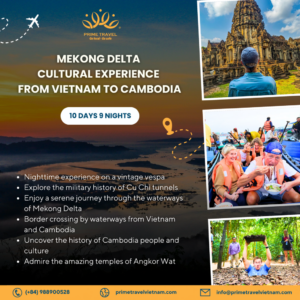
Essential Da Nang Guide and Itinerary: Best Things to Do for Travelers 2025
Visit Vietnam In July – Weather, Traditional Festival and Best Places To Visit 2025



